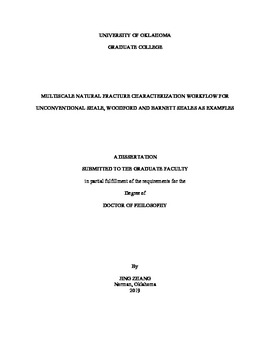| dc.description.abstract | This research presents an integrated methodology and workflow to characterize, interpret and predict natural fracture occurrence in different scales for unconventional shales using the Devonian-Mississippian Woodford and Barnett Shales in the midcontinent, United States as examples. The research projects are presented separately in the five chapters exhibiting different scales and objectives.
Chapter II is an introduction that summarizes basic knowledge, current understanding, general methodologies of characterization, and existing theories based on previous studies of natural fractures in unconventional shale reservoirs. This chapter will discuss conventional workflows, observation methods, and the advantages and disadvantages of alternative fracture characterization methods. Also review geomechanical analysis of unconventional reservoirs at different fracture scales.
Chapter III begins with a characterization of natural fractures seen in drilling core and outcrop of the Woodford Shale in southern Oklahoma. The core, located in a fault block in Caddo County, Oklahoma, falls within the Southern Oklahoma Aulacogen (SOA) depocenter near the northern rim of the Wichita Uplift. The outcrop is located on the northern rim of the Ardmore Basin and southern flank of the Arbuckle anticline in Carter County with an exposure of 81 feet of the Upper Woodford member and 10 feet of the Lower Woodford member. In addition to proximity, the core and outcrop Woodford Shale locations underwent similar intense tectonic deformation processes during the development of the Southern Oklahoma Aulacogen (SOA) and such that the observed are similar and well developed. After characterizing hardness, bed thickness, and fracture density, I examine that I correlate to fracture occurrence/density. These analysis well show
1
that the layering effect is the most dominant controlling factor of natural fracture density in these rocks.
Chapter IV is an extended study to quantify further how the layering effect can affect natural fracture density. A lab-based clay cake experiment was designed to mimic the brittle-ductile couplets feature, common to marine shales such as the Woodford Shale. The uniaxial compressional test was applied to the cylindrical shape mud layer model to create compressional fractures and simulate small-scale deformational scenarios in nature. Different groups of layer numbers with various thickness combinations were compared and quantified to explain how interbeds can control the distribution and density of natural fractures.
Chapter V examines the subject to reservoir scale fracture characterization using 3D seismic data. Centimeter-scale fractures characterized in the previous chapters might not be able to provide a significant contribution to the full field production flow. Thus, when considering larger-scale features, seismic data is more representative, consistent and reliable than core and logs with a limited area of coverage. Chapter V uses the Barnett Shale in North Texas, Fort Worth Basin as an example and presents an azimuthal anisotropy analysis on a wide azimuth, time migrated 3D seismic survey to correlate seismic anisotropy with natural fracture distribution. The new interpretation workflow is proposed to integrate and compare the different amplitude and velocity related seismic attributes anisotropy effect and how the interpretation can be used as an indicator for fracture network visualization.
Chapter VI is a summary chapter of the previous chapters. The integrated results are tied to reveal a bigger picture of natural fracture characterization for unconventional shales on different scales. A standardized characterization workflow is summarized to incorporate fracture characterization methods at all scales, which can be used for other shales. | en_US |

